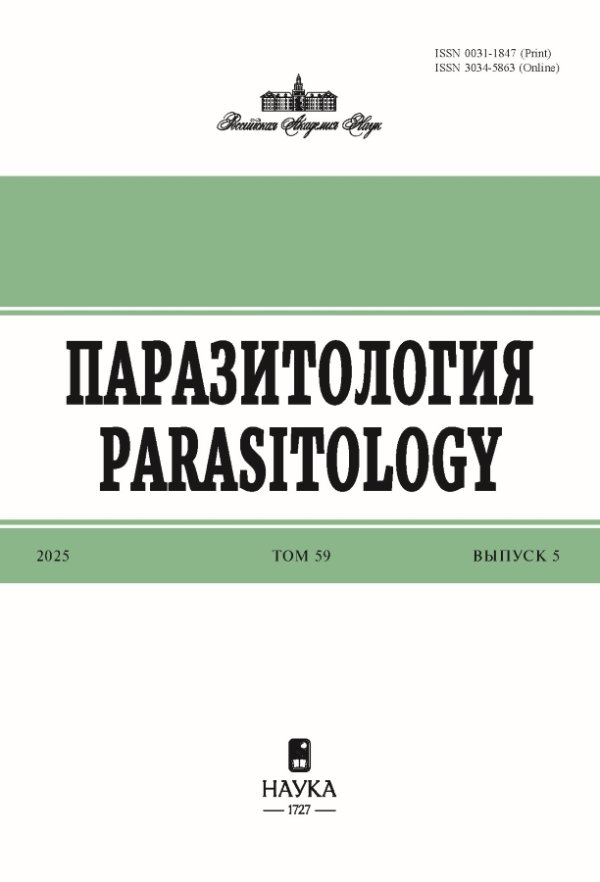Parasitology
ISSN (print): 0031-1847
Media registration certificate: No. FS 77 - 66711 dated July 28, 2016
Founder: Russian Academy of Sciences
Editor-in-Chief: Pugachev Oleg Nikolaevich
Number of issues per year: 6
Indexation: RISC, CrossRef, White List (level 3), Web of science
The journal "Parazitologiya" was founded in 1967.
"Parazitologiya" is the first and leading peer-reviewed scientific journal on parasitology published in Russia.
The aim of the journal is to facilitate parasitology research in Russia and worldwide by providing an efficient, high-quality and modern platform for scientific communication.
The scope of the journal embraces a wide range of parasitological topics, except for highly specialized aspects of medicine and veterinary science.
- Biodiversity, distribution and systematics. Descriptions of new species are welcome if they also contribute to some general conclusions.
- Wide range of research objects: any parasitic metazoans, fungi and protists, as well as bacteria and viruses — if the study has general parasitological relevance.
- Studies on morphology that broaden understanding of form and function in parasitic organisms.
- Ecological parasitology, life cycles and transmission pathways of parasites; phylogeography.
- Host-parasite interactions at different levels.
- Evolution, co-evolution and phylogeny.
- General and fundamental questions of parasitology.
- Vector-borne diseases with natural reservoirs (if the accent is on parasitology rather than medicine or veterinary science).
The journal is published 6 times a year in Russian and English languages. The name of the English version is Entomological Review.
The journal is presented in many databases, including the Web of Science and RSCI.
Current Issue
Vol 59, No 5 (2025)
Articles
MICROSPORIDIA INFECTING BENEFICIAL INSECTS WHICH SERVE AS BIOLOGICAL CONTROL AGENTS
Abstract
This review presents up-to-date data on microsporidian infections in beneficial insects used to control agricultural pests. Among these biocontrol agents, microsporidia have been reported predominantly from hymenopteran parasitoids and predatory insects belonging to various orders, mainly Holometabola. Parasitoids can be infected by pathogens specific for their hosts or bear their own parasites. Infections with microsporidia may cause serious pathologic changes or remain benign, while still affecting population dynamics of the insect pests against which the biocontrol agents are applied.
 339–351
339–351


MOLECULAR CHARACTERIZATION OF SRIVASTAVANEMA SP. FROM VIETNAMESE HAIRY-FOOTED FLYING SQUIRRELS BELOMYS PEARSONII (GRAY, 1842)
Abstract
Heligmonellidae is a family of parasitic nematodes that includes parasites of tropical and subtropical mammals. Flying squirrels (Pteromyini, Sciuridae) are one of the characteristic hosts of heligmonellid nematodes. The nematodes of the genus Srivastavanema were collected from the flying squirrel Belomys pearsonii during a zoological expedition of the Joint Russian-Vietnamese Center for Tropical Research and Technology. Morphological study of the nematodes was carried out using optical and scanning electron microscopy. Partial sequences of 28S rRNA gene and ITS2 region were also obtained. Phylogenetic analysis based on 28S rRNA revealed related forms within Mexican rodent parasites. Further analysis of the molecular phylogeny with the inclusion of other loci is necessary to resolve the current controversy between classifications based on molecular and morphological data.
 352–361
352–361


SEARCH AND GENETIC CHARACTERIZATION OF BACTERIA OF THE GENUS SPIROPLASMA SAGLIO ET AL. 1973 (CLASS MOLLICUTES) IN THE POPULATIONS OF APIS MELLIFERA L. (HYMENOPTERA, APOIDEA) OF EASTERN EUROPE AND WESTERN SIBERIA
Abstract
The present study reports the analysis of honey bee Apis mellifera L. populations for the presence of Spiroplasma Saglio et al. 1973 bacteria, known to cause May disease. Detection of Spiroplasma was performed using polymerase chain reaction with specific primers targeting the 16S rDNA region. A total of 212 bees from 18 regions across Eastern Europe and Western Siberia were examined. Spiroplasma infection was identified in three cases from two regions: the Udmurt Republic and Republic of Tatarstan. Phylogenetic analysis of nucleotide sequences revealed that two isolates belong to the Citri-Chrysopicola-Mirum clade, with one genetically identical to S. melliferum, a known bee pathogen. The third isolate was classified within the Ixodetis clade, commonly found among arthropods. Interviews with beekeepers from various regions reported no visible symptoms of May disease in their colonies. These findings suggest Spiroplasma bacteria may be present in honeybee populations without manifesting visible symptoms. Further in-depth studies are recommended in regions where these bacteria have been detected.
 362–377
362–377


FLEA SPECIES (SIPHONAPTERA) AS VECTORS OF PLAGUE IN NATURAL FOCI OF THE WORLD (PART 2)
Abstract
 378-416
378-416












